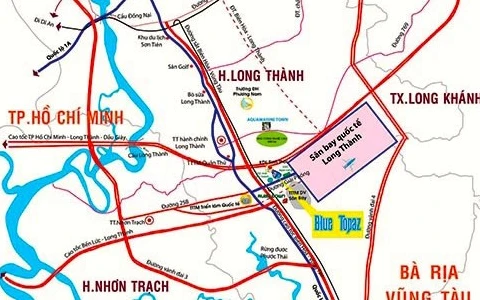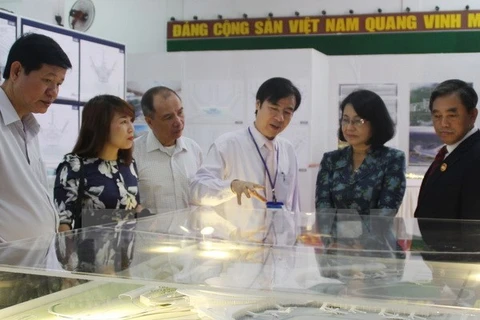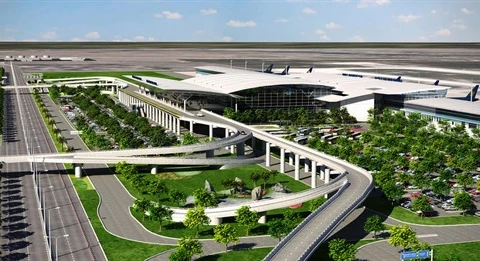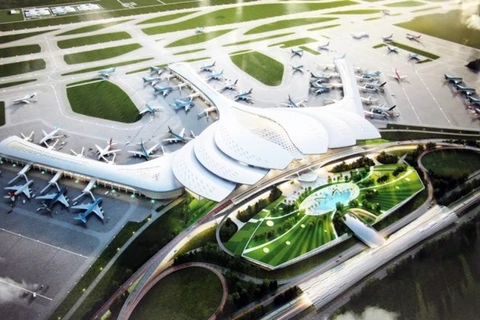Hanoi, (VNA) - Land clearance for the Long Thanh airport project in southern Dong Nai province should be sped up to prevent price slippage that will affect investment capital and to help people living in the project area stablise their living conditions, said National Assembly deputies on June 1.
They discussed land clearance, compensation and resettlement for the airport project after hearing a Government report on separating land clearance, compensation and resettlement tasks as a sub-project of the Long Thanh airport project which was announced more than a decade ago. The separation is expected to accelerate the progress.
Most of the deputies agreed with the report but pointed to the need for clear procedures, capital sources and implementation processes.
Deputy Pham Thi My Thanh from Dong Nai said planning for the airport project was announced more than ten years ago, if it was not implemented soon, many issues would arise such as price slippage or increased land prices.
Land clearance had cost 23 trillion VND (1.01 billion USD) from the initial estimate of 18 trillion VND, she said.
The project also affected residents living in this area, she said, with many worrying about what they would do after being resettled to allow the project to be constructed.
Enterprises in the project area also faced difficulties, she said.
Many deputies agreed, saying that land prices kept increasing and would affect the project’s investment capital if land clearance was not implemented soon.
Lawmakers also pointed to the need to ensure living conditions of residents who will have land revoked to construct the airport.
Deputy Nguyen Thi Quyet Tam from HCM City said careful studies should be made so affected residents have better living conditions after being relocated.
“It is necessary to consider many issues for the residents when they are relocated such as employment and education for their children,” she said.
Land clearance and compensation should be carefully discussed and supervised as the project covers more than 5,000ha, she said.
Many deputies also noted that while waiting for Long Thanh airport to be constructed, investment should be poured into improving the capacity of Tan Son Nhat International Airport in HCM City, which they said is currently overloaded.
The 336.7 trillion VND (16 billion USD) Long Thanh International Airport project was approved by a majority of the National Assembly deputies at the 13th NA’s ninth session in 2015.
It is expected to reduce the load on neighbouring Tan Son Nhat Airport.
The airport will be able to handle 100 million passengers and five million tonnes of freight a year. The investment will come from various sources, such as the State budget, Official Development Assistance and corporate capital.
The project has been divided into three phases. The first phase, expected to be completed in 2025 and handle 25 million passengers and 1.2 million tonnes of freight a year, includes the construction of a runway, a terminal and supporting infrastructure.
Following the approval, the NA issued a resolution asking for detailed plans for the construction, including site clearance, compensation, employment and re-settlement and support for those who would be displaced.
Earlier the same day, deputies discussed the draft revision of the Law on Legal Aid.
They agreed on the importance of revising the law to tackle existing shortcomings in legal aid and create a legal framework to make legal aid activities more professional while effectively using resources when providing legal services.
They proposed mobilising social participation for legal aid to reduce the burden on the State budget.
Deputies also touched on the need to review practical demands, anticipate resources for law enforcement in accordance with the country’s socio-economic situation, and ensure the regulations’ feasibility.-VNA
They discussed land clearance, compensation and resettlement for the airport project after hearing a Government report on separating land clearance, compensation and resettlement tasks as a sub-project of the Long Thanh airport project which was announced more than a decade ago. The separation is expected to accelerate the progress.
Most of the deputies agreed with the report but pointed to the need for clear procedures, capital sources and implementation processes.
Deputy Pham Thi My Thanh from Dong Nai said planning for the airport project was announced more than ten years ago, if it was not implemented soon, many issues would arise such as price slippage or increased land prices.
Land clearance had cost 23 trillion VND (1.01 billion USD) from the initial estimate of 18 trillion VND, she said.
The project also affected residents living in this area, she said, with many worrying about what they would do after being resettled to allow the project to be constructed.
Enterprises in the project area also faced difficulties, she said.
Many deputies agreed, saying that land prices kept increasing and would affect the project’s investment capital if land clearance was not implemented soon.
Lawmakers also pointed to the need to ensure living conditions of residents who will have land revoked to construct the airport.
Deputy Nguyen Thi Quyet Tam from HCM City said careful studies should be made so affected residents have better living conditions after being relocated.
“It is necessary to consider many issues for the residents when they are relocated such as employment and education for their children,” she said.
Land clearance and compensation should be carefully discussed and supervised as the project covers more than 5,000ha, she said.
Many deputies also noted that while waiting for Long Thanh airport to be constructed, investment should be poured into improving the capacity of Tan Son Nhat International Airport in HCM City, which they said is currently overloaded.
The 336.7 trillion VND (16 billion USD) Long Thanh International Airport project was approved by a majority of the National Assembly deputies at the 13th NA’s ninth session in 2015.
It is expected to reduce the load on neighbouring Tan Son Nhat Airport.
The airport will be able to handle 100 million passengers and five million tonnes of freight a year. The investment will come from various sources, such as the State budget, Official Development Assistance and corporate capital.
The project has been divided into three phases. The first phase, expected to be completed in 2025 and handle 25 million passengers and 1.2 million tonnes of freight a year, includes the construction of a runway, a terminal and supporting infrastructure.
Following the approval, the NA issued a resolution asking for detailed plans for the construction, including site clearance, compensation, employment and re-settlement and support for those who would be displaced.
Earlier the same day, deputies discussed the draft revision of the Law on Legal Aid.
They agreed on the importance of revising the law to tackle existing shortcomings in legal aid and create a legal framework to make legal aid activities more professional while effectively using resources when providing legal services.
They proposed mobilising social participation for legal aid to reduce the burden on the State budget.
Deputies also touched on the need to review practical demands, anticipate resources for law enforcement in accordance with the country’s socio-economic situation, and ensure the regulations’ feasibility.-VNA
VNA
























